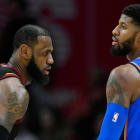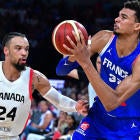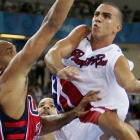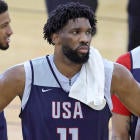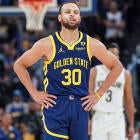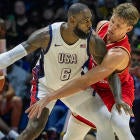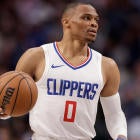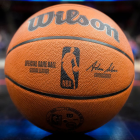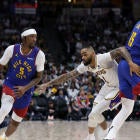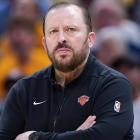The Los Angeles Lakers were the big winners of Thursday's trade deadline. By trading Jordan Clarkson and Larry Nance Jr. to the Cleveland Cavaliers for Isaiah Thomas, Channing Frye and the Cavs' 2018 first-round draft pick, they opened up enough cap space to sign two maximum-salaried free agents this summer. Everybody in the league knew they wanted to do this, and they found a way.
Why is it important that the Lakers have space for two max salary slots? Reader, you already know the answer: This is a franchise obsessed with chasing superstars, and there are a couple of them who could be interested in meeting with Magic Johnson and the rest of the front office in July: LeBron James and Paul George.
Landing LeBron and George -- or LeBron and DeMarcus Cousins, or LeBron and a couple of role players, whatever -- would immediately become one of the biggest moments in Lakers history. Los Angeles doesn't have to pull off something historic, though, to make the trade worth it. The big thing here is that, along with a number of solid, improving young players, the Lakers now have options. With the help of The Capulator, ShamSports' new tool for calculating the salary cap, let's have a look at a few possible outcomes.
The dream scenario: Signing LBJ and PG
Just take a look at this cap sheet. The Lakers would renounce the rights to all their free agents and wind up with Lonzo Ball, Brandon Ingram, Kyle Kuzma, Josh Hart and whoever they take with the pick from the Cavs on rookie contracts, James at his max and George slightly below his max. (He is eligible to sign a deal with a starting salary of $30.3 million.) I put George on a two-year deal because it allows him to opt out and sign a new deal when he has 10 years of NBA experience -- the veteran max lets a player sign for 35 percent of the salary cap.
If they pulled this off, they would obviously need to find some guys to play center. As the Golden State Warriors have shown the last few seasons, though, this can be done without breaking the bank. Los Angeles will have the $4.4 million room midlevel exception to sign someone, and the rest of the roster would be filled out with minimum-salary guys … unless Johnson and general manager Rob Pelinka find a way to unload Luol Deng's massive contract, which expires in 2020.
By the way, in today's NBA, I don't see why this version of the Lakers couldn't get away with playing their best five players together for stretches: Ball, Ingram, George, James and Kuzma. Sure, you lack rim protection, but they can switch just about everything and they'd be impossible to stop.
The riskier proposition: Signing PG and DMC
What if LeBron decides to stay in Cleveland? That should not destroy Los Angeles' hopes of revamping its roster in July. If George wants to play at home and Cousins is interested in joining him, Johnson and Pelinka could construct a dangerous and balanced roster through free agency.
The downside is that Cousins just tore his Achilles, and the Lakers know better than anybody that this is a serious injury. One way to mitigate that downside: sign Cousins to a two-year deal. If he gets back to his old self and this partnership works, they can re-sign him to the 10-year max the next time he hits free agency. If not, they can part ways.
In this scenario, Ball, Ingram, George, Kuzma and Cousins would be the likely starting five. That's a huge lineup, but it's quick, too. There's no LeBron, but the Lakers get to keep their young guys and add two legitimate All-Stars. This justifies dumping Nance and Randle, and it basically means their window to compete for a title opens as soon as Ball and Ingram are ready for prime time. With $4.1 million in cap space and the $4.4 million room exception, Los Angeles would be able to add two more role players before resorting to minimum deals.
The patient plan: Waiting until 2019
There are various other permutations where they spend all their money this summer -- what about going after Aaron Gordon or Jabari Parker in restricted free agency? -- but let's focus on the big swings the front office wants to take. If they lose out on LeBron and George, let Julius Randle walk and save their money, they could be in the mix for Kawhi Leonard, Jimmy Butler, Klay Thompson and Khris Middleton a year later.
Let's say they get the No. 1 and No. 4 guys on that list, with Leonard taking the max and Middleton taking a starting salary of $20 million. That gives them a superstar and a fringe star in their prime to play with Ball, Ingram and Kuzma as they are coming into their own. Hart will still be on the roster, too, as will the player they draft this summer with the Cleveland pick and the player they draft with their own pick in 2019.
I didn't bother using the cap space in 2018 in this simulation, but they could conceivably get a few guys on Kentavious Caldwell-Pope-like one-year deals. It is important they figure out a strategy there because that will influence how they perform next season and, thus, where their pick falls. Here, we are assuming the Lakers remain one of the league's worst teams and end up with the No. 2 pick. This would be nice, but let's look at a different situation …
A 2019 alternative: Striking gold
Let's say the Lakers get the 10th pick instead of the second pick in 2019. That would give them two maximum slots, without having to dump any additional players or move the Deng contract. This could let them sign Leonard and Thompson (or Butler and Thompson, or Leonard and Butler, you choose).
I know signing LeBron would be the best-case scenario, but this might be my favorite outcome. Leonard and Ingram can do the bulk of the playmaking, with Ball and Thompson fitting in to make their lives easier in their distinct ways. Leonard would only be 28 at this point and Thompson would be 30. It is unclear if these guys would want to leave the situations they're in now, but a lot can change in between now and then.
Essentially, the Lakers are in a position of strength because of the trade they made. They have a bunch of good players on rookie contracts, and they have two chances to hit a home run in free agency before they have to pay Ingram. The LBJ-PG dream is what everybody is talking about, but the cap space could be used in other ways, whether it involves these 2019 free agents or absorbing another team's disgruntled franchise player in a trade. Every front office in the league values flexibility, and the Lakers suddenly have that. Let's see how they use it.









